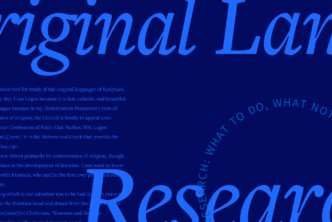Our Savior was a master of enigma, a device by which he made his hearers think. In Matthew 6:22–23 we find a teaching whose initially enigmatic character resolves, under patient study, into delightful clarity.
The eye is the lamp of the body. So, if your eye is healthy, your whole body will be full of light, but if your eye is bad, your whole body will be full of darkness. If then the light in you is darkness, how great is the darkness! (ESV)
Light and darkness in this passage clearly refer to morality. Our nature as sinners created in God’s image results in this dual moral character: good and evil. The passage’s final statement is an exclamation that the person whose very best is thoroughly evil is evil indeed, beyond measure. This much is easy enough to understand.
What, though, does the eye have to do with it? The words “healthy” and “bad” seem to imply that Jesus is talking about the physical organ, but in context a moral reference seems more likely. While many plausible guesses have emerged, a search for other passages using the same or similar language is methodologically wise and, as happens often, yields information that renders such guesswork unnecessary.
First, though, let’s notice the variety of renderings found among major English versions for the Greek words translated by the ESV as “healthy” and “bad.”
| KJV | single/evil | NKVJ | good/bad |
| RSV | sound/ not sound | NRSV | healthy/ unhealthy |
| NASB | clear/bad | NET | healthy/ diseased |
| CSB | healthy/bad | NIV | healthy/ unhealthy |
Most of these versions imply that Jesus is talking—at least on the concrete level in this figurative passage—about the physical eye’s functional condition. The KJV, though, points us in a slightly different direction that provides a better understanding.
The bad eye
Many cultures have an expression, “the evil eye,” for various kinds of destructive actions or dispositions. The Hebrew Old Testament uses this exact expression or a very close parallel at least five times (Deut. 15:9; 28:54, 56; Prov. 23:6; 28:22). Each relates to money or material things and refers to viewing others through the lens of one’s own wealth or gratification. The basic idea of the “evil eye” in the OT, then, is greed or covetousness.
This meaning perfectly fits Jesus’ use of the expression in Matthew 20:15, in reply to the day-long workers in the vineyard who protest that they received no greater pay than those who found labor only at the eleventh hour: “Do you begrudge my generosity?” (ESV), which, translated literally, reads, “Is your eye evil because I am good?”
Those whom Jesus portrays as in moral darkness (v. 23b), then, are those who view and treat others selfishly, especially in the material realm, as the extended context of Matthew 5 supports. Though material wealth may get the focus, more psychological forms of narcissism seem to warrant inclusion as well.
The healthy eye
From here it becomes easy to understand what Jesus means, in contrast, by the “healthy” or “single” eye. The basic meaning of the Greek adjective here (haplous) is that something is single that might possibly instead be multiple or divided. The person with an “evil eye” often has a dual agenda: a generous exterior masking a greedy heart. Those with a “single eye” have no greed to mask: they view others, rather, as people whom they can selflessly serve. This understanding of the expression strongly coincides with other NT usages of this word family (see the Logos Bible Word Study note below), which strongly feature self-giving service and devotion. Only with such a selfless outlook will we have the moral clarity to see life’s issues rightly (and thus find true joy!); covetousness and narcissism blind and leave us in the profoundest moral darkness.
***
Note: Logos Bible Word Study
The Logos Bible Word Study tool can show you, even if you don’t know Greek, the other New Testament words that come from the same root as the word you’re studying.
***
Randy Leedy, former longtime Greek professor at Bob Jones University Seminary, is best known as the author of the Greek New Testament Sentence Diagrams originally published in BibleWorks and now available in Logos Bible Software. At his website, NTGreekGuy.com, the diagrams are also available in PDF form, along with a variety of resources to support Greek sentence diagramming. Randy has also authored as a Logos title a biblical-theological study of the world in both testaments, entitled Love Not the World: Winning the War against Worldliness.
This article was originally published in the July/August 2022 issue of Bible Study Magazine. Slight adjustments, such as title and subheadings, may be the addition of an editor.




